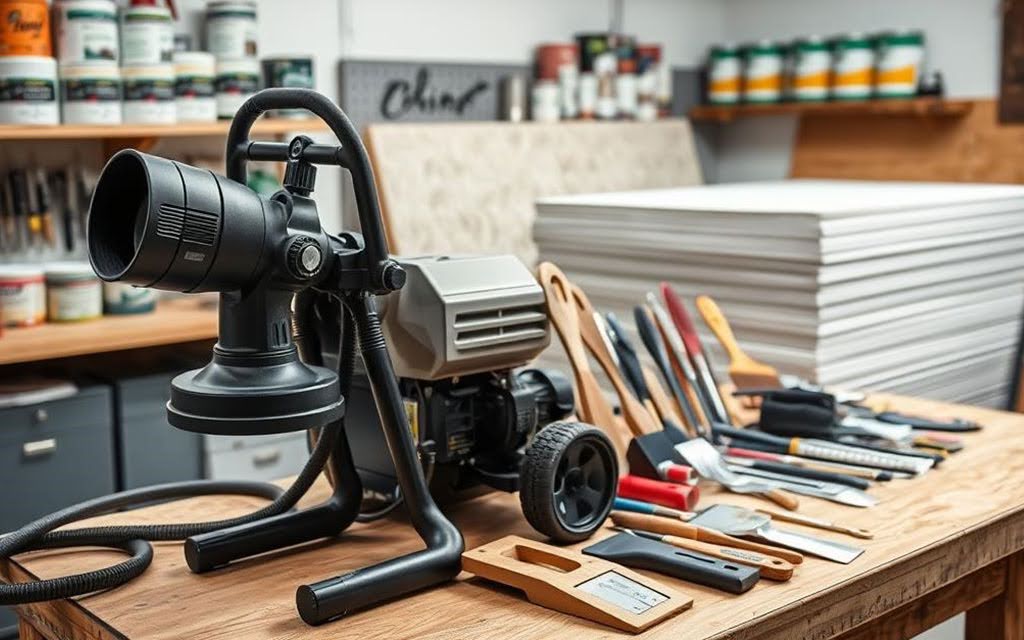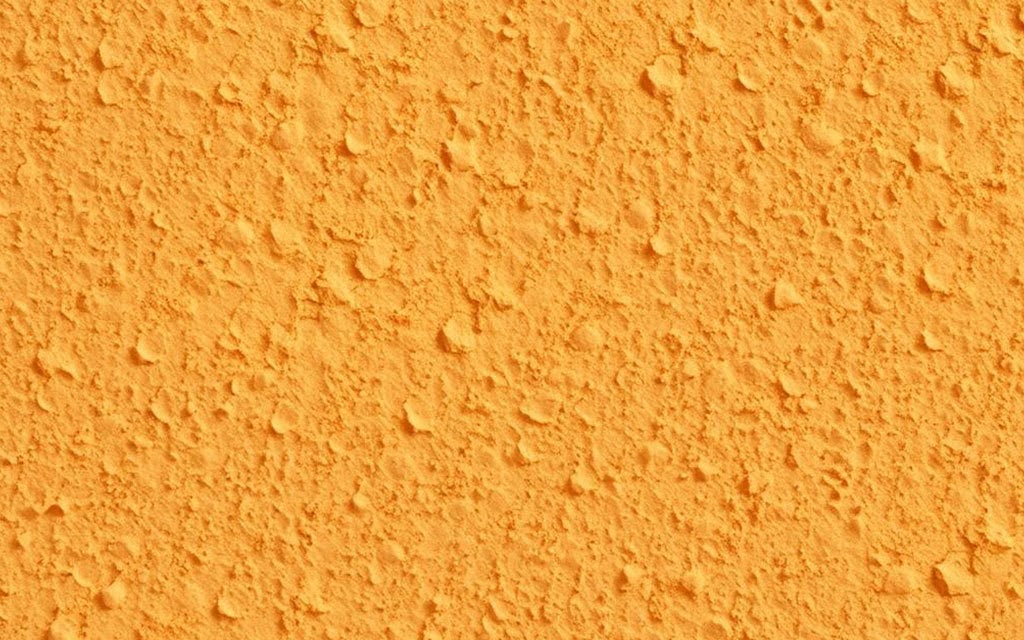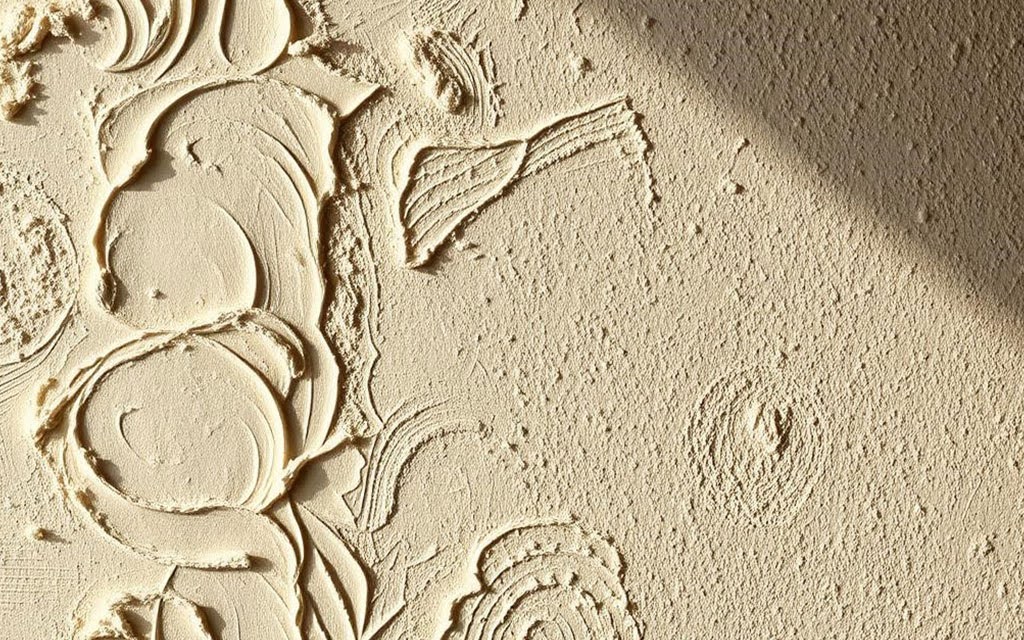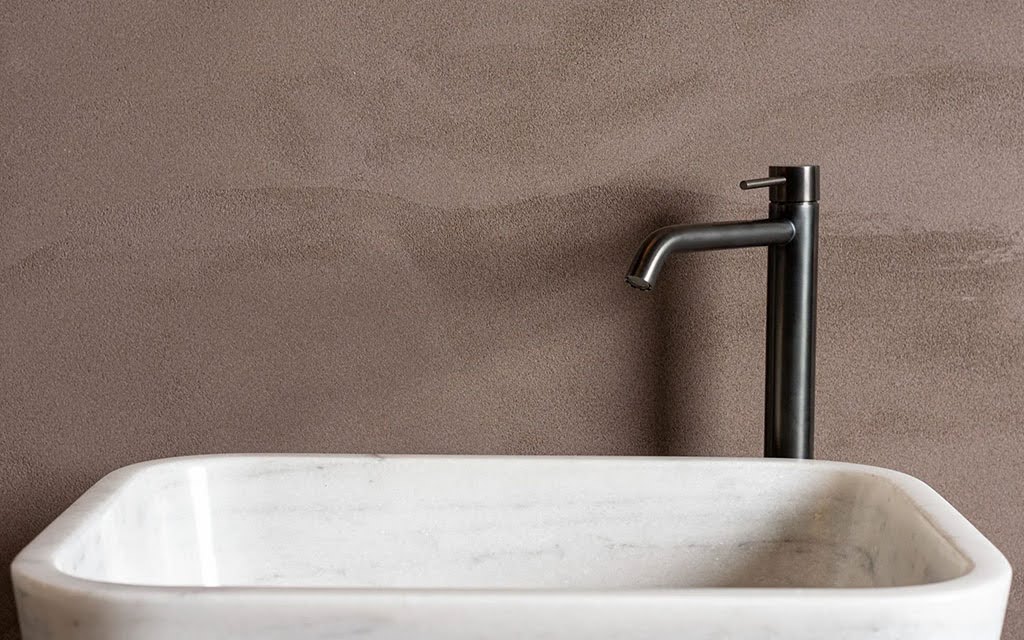Tipos básicos de texturas murales y sus aplicaciones
Wall texture styles play a crucial role in modern home design, offering homeowners versatile solutions that can effectively hide flaws, add visual depth and dimension, and create unique atmospheres that reflect personal taste. Let’s explore the most popular wall texture types and examine their practical applications in both interior and exterior spaces, helping you understand which options might work best for different areas of your home.
Texturas populares para paredes interiores
Interior wall textures span a wide spectrum from subtle and understated to bold and dramatic, giving you plenty of creative freedom when designing your space. For a comprehensive comparison of types of interior wall finishes including both textured and smooth options, explore our complete guide. Textura de piel de naranja gets its name from mimicking the dimpled surface of an orange’s skin, and it offers a soft, contemporary look that works beautifully in modern homes while remaining timeless enough to suit traditional spaces as well. Textura de derribo, which is essentially a flattened version of orange peel that’s been smoothed with a drywall knife, adds more pronounced visual interest through its varied patterns and subtle shadows that catch and reflect light in interesting ways. Textura de palomitas, which remains common on ceilings throughout many homes despite falling out of favor in recent decades, excels at hiding imperfections in the wall surface and also provides excellent sound absorption properties that can reduce noise between floors and rooms.
Texturas comunes de paredes exteriores
Exterior textures face the additional challenge of withstanding harsh weather conditions, intense sunlight, driving rain, and temperature fluctuations that can damage less durable finishes. For detailed information about types of exterior wall finishes including stucco, textured paint, and cladding options, see our comprehensive guide. Stucco remains a classic choice that homeowners have trusted for generations, providing both exceptional durability that stands up to the elements and timeless charm that enhances any architectural style. Learn more about tipos de enlucidos exteriores like traditional stucco, synthetic stucco (EIFS), and modern acrylic systems in our specialized guide. Textured paint offers a simpler, more budget-friendly option for homeowners who want to add depth and visual interest to exterior walls without the complexity and expense of traditional stucco application, making it an increasingly popular choice for quick home updates.
El papel de las texturas en el diseño del hogar
The texture style you choose can significantly impact the overall ambiance and feel of any room, influencing how people perceive and interact with the space. Subtle textures like gentle swirls or fine comb patterns can add warmth and visual interest to a room without overwhelming the senses or competing with other design elements like furniture, artwork, and window treatments. Bold, dramatic textures naturally become focal points that draw attention and create conversation, making them ideal for accent walls or spaces where you want to make a strong design statement. Professional interior designers frequently use texture strategically to balance spaces by adding visual weight where needed, create compelling contrast between smooth and textured surfaces, and influence how light reflects and moves throughout a room. Choosing the right wall texture for your home can transform a plain, uninspiring room into a captivating space that feels intentionally designed and professionally finished.
| Tipo de textura | Características | Mejor uso |
| Piel de naranja | Subtle, spray-applied with light dimples | Living rooms, bedrooms, hallways |
| Knockdown | Flattened peaks creating diverse patterns | Hallways, dining rooms, family rooms |
| Palomitas de maíz | Bumpy, sound-absorbing with cottage cheese appearance | Ceilings, home theaters, basements |
| Remolino | Circular patterns with elegant, flowing lines | Accent walls, entryways, formal spaces |
| Peine | Linear grooves that are highly customizable | Modern spaces, offices, contemporary homes |
Diferentes Texturas de Pared: Del estilo clásico al contemporáneo
Wall textures add remarkable depth and character to any room, transforming flat, lifeless walls into dynamic surfaces that engage the eye and create visual interest. You can choose from classic options like textura de pincel that brings rustic, hand-crafted appeal, or opt for modern finishes like saltar textura llana that deliver contemporary sophistication—each style possessing its own unique features and aesthetic qualities that make it suitable for different design approaches.
The slap brush texture gives walls a delightfully rustic, hand-crafted look that feels warm and inviting, making it particularly effective for adding cozy character to living rooms or bedrooms where you want people to feel comfortable and relaxed. Sand swirl texture offers a more subtle yet undeniably elegant finish that works beautifully in formal spaces like dining rooms, where you want sophistication without overwhelming guests with too much visual texture. The texture brush used in this application creates graceful patterns that catch light beautifully while maintaining an understated elegance.
For homeowners seeking a modern aesthetic, skip trowel texture stands out as a top choice among popular wall texture types because it leaves walls with a smooth yet slightly textured surface that’s ideal for contemporary homes with clean lines and minimalist sensibilities. Lace drywall texture, recognized for its delicate, intricate patterns that resemble fine lace fabric, adds a touch of sophistication to any room, creating an elegant wall finish that feels both luxurious and refined.
When you’re choosing the right wall texture for different rooms in your home, it’s important to think carefully about each room’s specific purpose and how your chosen texture fits within your overall design theme. For example, knockdown texture suits high-traffic living areas exceptionally well because it’s durable and hides wall imperfections effectively, while the lustrous finish of Venetian plaster shines brightest in kitchens and bathrooms where its moisture-resistant properties and easy-to-clean surface provide both beauty and practicality. To learn more about types of interior plaster finishes including Venetian plaster, skip trowel, and specialty decorative plasters, visit our detailed guide. Coastal-inspired designs pair wonderfully with sand swirl textures that evoke the natural patterns found in beach sand, and industrial-style interiors often feature exposed brick textures or rough-hewn finishes that emphasize raw, authentic materials.
| Tipo de textura | Lo mejor para | Mantenimiento | Estilo |
| Piel de naranja | Living Rooms, Bedrooms | Low – easy to clean | Subtle, Contemporary |
| Knockdown | Zonas de tráfico intenso | Medium – occasional touch-ups | Versatile, Rustic |
| Saltar la paleta | Modern Spaces, Minimalist Homes | Low – durable finish | Contemporary, Sleek |
| Yeso veneciano | Kitchens, Bathrooms | High – requires sealing | Elegant, Luxurious |
Lighting plays an absolutely critical role in determining how wall texture looks in your space, as different light sources and angles can dramatically change the appearance and impact of textured surfaces. Natural sunlight streaming through windows makes subtle textures like orange peel really pop and come alive, creating beautiful shadow patterns that shift throughout the day as the sun moves across the sky. Strategic artificial lighting, including directional spotlights and wall sconces, can dramatically highlight bold textures like Venetian plaster, creating depth and dimension that’s especially striking in the evening hours when your home’s interior lighting takes center stage. By carefully choosing the right unique texture and considering how different types of lighting will interact with that surface, you can transform your space into something that’s truly your own and reflects your personal aesthetic vision.
Herramientas y materiales esenciales para texturizar paredes
Wall texturing transforms simple, flat surfaces into stunning works of art that add character and personality to any space, but achieving professional-quality results requires having the right tools and materials on hand before you begin. Let’s examine what equipment you’ll need for successful texture application, whether you’re a seasoned professional contractor or an ambitious DIY enthusiast taking on your first texturing project.
Equipo profesional de texturizado
Professional contractors and experienced tradespeople rely on specialized gear that enables fast, efficient, and even texture application across large surface areas. A professional-grade texture machine is an absolute must-have tool for serious texturing work, and these sophisticated devices come in different configurations including hopper-style units and self-contained sprayers designed to handle various project sizes and application requirements.
Herramientas de texturización DIY
For home improvement projects where you’re working on a smaller scale, you can achieve amazing results using simpler, more affordable tools that are readily available at your local hardware store. A quality drywall knife serves multiple purposes and proves invaluable for creating smooth knockdown textures by flattening the peaks after spray application. Thick-nap paint rollers work exceptionally well for applying texture material evenly to the wall surface, ensuring consistent coverage that forms the foundation for beautiful finished results. Versatile texture brushes open up possibilities for creating many different patterns and effects, from random slap brush applications to carefully controlled swirl designs.
Elegir el compuesto adecuado para paneles de yeso
Picking the appropriate compuesto de yeso remains absolutely vital to achieving the texture results you envision, as different formulations behave differently and produce distinct finishes. Pre-mixed compound saves considerable time and eliminates the guesswork involved in mixing, though you might need to thin it slightly with water depending on your specific application method and desired consistency. Powder compounds, which you mix yourself using a dry mix of drywall mud and water, give you much more precise control over consistency, allowing you to adjust the thickness to match your exact needs. For most common texture applications, mixing drywall mud with water at approximately a 4:1 ratio produces the ideal consistency, though you may need to experiment slightly to find the perfect mixture for your particular technique.
| Herramienta | Primary Use | Best Texture Type |
| Pulverizador de texturas | Covering Large Areas Quickly | Cáscara de naranja, palomitas de maíz |
| Cuchillo para tabiquería seca | Smoothing and Creating Patterns | Knockdown, Skip Trowel |
| Esponja | Creating Faux Finishes | Sponge Painting, Special Effects |
Don’t forget the crucial step of priming the wall surface thoroughly before you apply texture, as proper primer creates the ideal foundation for texture material to adhere properly and last for years. After your texture has dried completely and you’re ready for the finishing touches, use flat or matte paint rather than glossy finishes to make the texture really pop and showcase all those beautiful shadows and depth. Armed with these essential tools and high-quality materials, you’re well-prepared to create beautiful textured walls that will enhance your home’s aesthetic appeal for decades to come.
Técnicas y aplicaciones de texturas en spray
Spray texture techniques represent some of the quickest and most efficient methods available for texture application, making them especially popular among both professional contractors and DIY enthusiasts who need to cover large areas. These versatile techniques work wonderfully for making walls and ceilings look more interesting and visually appealing while hiding minor imperfections. Let’s explore some of the most common spray application types and examine how they’re used in real-world situations to transform ordinary surfaces into textured masterpieces.
Método de textura de piel de naranja
The orange peel wall texture method has earned tremendous popularity among homeowners and remains one of the most requested finishes because it beautifully mimics the distinctive dimpled surface of the skin of an orange, creating a subtle yet appealing visual effect. Applying an orange peel texture requires using a special hopper gun sprayer connected to an air compressor, which atomizes the compuesto de yeso mixture and allows you to spray it onto the wall or ceiling in controlled patterns that create those characteristic small bumps and dimples.
Aplicación de techos de palomitas de maíz
Textura de palomitas appears frequently on ceilings throughout homes built from the 1950s through the 1980s, valued primarily because it dramatically reduces noise and echo in rooms by absorbing sound waves. This distinctive finish resembles cottage cheese or, as its name suggests, popped popcorn kernels, creating a bumpy, three-dimensional surface. The application process involves mixing drywall mud and polystyrene together with water to achieve the proper consistency, then spraying this mixture onto the primed drywall underneath using a hopper gun, which deposits the material in a way that creates those characteristic peaks and bumps. Though popcorn texture has fallen somewhat out of fashion in modern home design, it still proves valuable in situations where sound dampening is important, such as home theaters, music rooms, or multi-story homes where you want to reduce noise transmission between floors.
Técnicas de pulverización de arena
Sand spray textures give walls and ceilings a pleasantly gritty, dimensional appearance by incorporating fine sand particles into the texture material before application. This technique involves carefully mixing sand with either paint or compound, creating a slurry that’s then sprayed on the wall using specialized equipment that can handle the added thickness and texture of the sand-infused mixture. The resulting finish makes walls look more interesting and dynamic while simultaneously helping to hide small imperfections and flaws that might be visible with smoother finishes.
Remember to always test your spray texture technique on scrap material or an inconspicuous area first, allowing you to perfect your application method and adjust your equipment settings before committing to spraying every wall in the room. Most aerosol texture cans cover approximately 75-125 square feet depending on how heavily you apply the texture material, so calculate your needs carefully and purchase adequate supplies. Always wear appropriate protective gear including safety glasses and a quality respirator mask, and ensure the work area remains well-ventilated throughout the entire application process to protect your health and safety.
Métodos de texturizado y patrones aplicados a mano
Hand-applied wall texture techniques add unique charm and artisanal character to your home, offering an appealing alternative to machine-sprayed finishes that can sometimes feel impersonal or overly uniform. These methods give you direct control over the application process and allow extensive customization, enabling you to create stunning wall textures that reflect your personal aesthetic vision. The possibilities range from relatively smooth, subtle finishes all the way to intricate, highly detailed patterns, offering endless creative options for expressing yourself through your home’s interior design.
Applying texture with a roller represents a favorite method among many DIY enthusiasts because it’s straightforward and doesn’t require expensive specialized equipment beyond what most homeowners already have. This technique requires using a special roller designed for texture work along with properly mixed compound that’s been thinned to the appropriate consistency. By strategically changing the pressure you apply and varying the direction of your roller strokes, you can create distinctly different patterns and achieve various depths of texture across the wall surface. For achieving smooth textures with minimal visible roller marks, professionals recommend using a fine-nap roller and applying thin layers of compound, building up gradually rather than trying to achieve full coverage in a single pass.
Trowel-based techniques provide even more artistic freedom and control, allowing skilled applicators to create truly custom finishes that look hand-crafted and intentional. The skip trowel method produces a rustic, intentionally uneven finish by literally skipping the trowel across the wall surface in irregular patterns, leaving some areas heavily textured while other sections remain relatively smooth. The Santa Fe texture, named after the Southwestern architectural style it complements so beautifully, uses a wide drywall knife to create smooth, flowing layers of texture that overlap and blend together seamlessly.
- Swirl: Use a specialized brush or circular trowel to create graceful circular patterns that flow across the wall surface
- Slap Brush: Apply compound generously with a stiff-bristled brush, then slap it against the wall in a random pattern to create organic, artistic texture
- Rosebud Stomp: Create an attractive floral-like pattern using a specialized stomping tool that leaves distinctive rounded impressions
Each texture technique uses different tools and requires mastering specific application methods, but this variety allows you to customize your walls extensively and create finishes that are truly one-of-a-kind. Remember that proper surface preparation and dedicated practice remain absolutely key to achieving professional-looking results with hand-applied textures—don’t expect perfection on your first attempt, but know that your skills will improve rapidly with experience and patience.
Técnicas avanzadas de textura: Knockdown y Skip Trowel
Textura de derribo y skip trowel drywall texture represent advanced finishing techniques that skilled professionals use to add remarkable depth and character to walls throughout upscale homes and commercial spaces. These sophisticated techniques create unique, eye-catching patterns that effectively hide imperfections while simultaneously elevating the overall interior design aesthetic and creating surfaces that feel custom and intentional.
Creación de la textura Knockdown
Knockdown wall texture gets created through a multi-step process that begins by applying drywall compound to the wall in a relatively thick layer using either a spray gun or roller, ensuring even coverage across the entire surface. After the compound has been sprayed on the wall and allowed to set briefly, you use a wide, flat blade to carefully flatten the peaks while they’re still somewhat wet but have begun to firm up, a crucial timing that determines the final appearance. This flattening process results in a beautifully mottled finish that closely resembles traditional stucco, with varied patterns of highs and lows that catch light in interesting ways. The knockdown texture adds an appealing aged look to walls while covering flaws in the wall surface effectively, making it particularly valuable in older homes or situations where the underlying drywall isn’t perfectly smooth.
Pasos de la aplicación de Skip Trowel
Skip trowel drywall texture involves the careful application of multiple thin layers of joint compound rather than one thick coat, building depth gradually through repeated passes. You apply the texture material using uneven, skipping strokes with a hawk and trowel held at specific angles, deliberately leaving some areas of the wall relatively smooth while building up compound in other sections. This intentionally irregular application method creates a rustic, hand-crafted appearance that texture adds charm and warmth to any room, making spaces feel more intimate and personally designed rather than mass-produced or generic.
Lograr resultados profesionales
For consistently excellent results when working with these advanced texture techniques, always apply joint compound at approximately a 15-degree angle to the wall surface, which helps the material spread smoothly without creating ridges or lines. Use a light, controlled touch throughout the application process to avoid over-smoothing the texture, which would eliminate the dimensional qualities that make these finishes so appealing in the first place. Typical drying time runs approximately 24 hours before you can safely prime and paint over the texture, though humidity levels and temperature can affect this timeline significantly. Project costs range dramatically from around $30 for small DIY repairs to $1,000 or more for professional installation throughout an entire room, depending on factors like room size, ceiling height, and the complexity of the chosen texture pattern. Combining different textures with carefully selected paint colors and finishes creates modern designs that add compelling visual interest to your space while maintaining a cohesive, professional appearance throughout.
- Use textured rollers, sharp taping knives, and quality spray texture equipment to achieve varied effects and maintain consistency
- Practice extensively on small areas, spare pieces of drywall, or inside closets to perfect your technique before tackling highly visible walls
- Adjust your application speed and pressure based on room humidity levels and climate conditions, as environmental factors significantly impact how quickly compound dries
Mantenimiento y reparación de paredes con textura
Textured walls bring valuable depth and character to any room, but like all surfaces in your home, they can develop imperfections and show wear over time that detracts from their appearance. Regular maintenance combined with proper repair methods remains essential for keeping textured surfaces looking great and maintaining your home’s overall aesthetic appeal. Whether your walls feature smooth textures with barely perceptible variation or showcase detailed, intricate designs with deep relief, addressing issues promptly prevents small problems from becoming major headaches that require extensive and expensive repairs.
Begin any repair project by carefully assessing the damage and gathering all the necessary tools before you start working, as proper preparation makes the actual repair process much smoother and more successful. For repairing small cracks or chips in textured surfaces, you’ll typically need drywall compound, joint tape for reinforcing larger cracks, fine-grit sandpaper for smoothing, and basic application tools. Start by thoroughly cleaning the damaged area to remove any loose debris, dust, or flaking paint, then apply reinforcing tape to any cracks that extend more than an inch or two to prevent them from reopening after your repair dries.
Next, carefully spread compound over the damaged area using a putty knife, attempting to match the existing texture as closely as possible—this matching step represents the most challenging aspect of textured wall repair. For more serious issues like water damage that has compromised the drywall’s structural integrity, you might need to cut out and completely remove the damaged section down to the studs, then install new drywall before attempting any texture application.
Successfully recreating the original texture pattern proves to be the absolute hardest part of repairing textured walls, requiring patience, practice, and often several attempts before achieving satisfactory results. Try using appropriate tools like sponges for stippled finishes, brushes for slap or stomp textures, or sprayers for orange peel and knockdown to replicate the existing pattern. Exercise caution to avoid adding too much texture, as excess buildup can be glaringly noticeable and actually draw more attention to the repair than the original damage did. After you let the texture dry completely for at least 24 hours, carefully prime the repaired area and paint it to blend seamlessly with the surrounding wall surface.
For complex textures that require specialized skills, extensive damaged areas covering more than a few square feet, or repairs in highly visible locations where imperfect matching would be obvious, seriously consider getting professional help from experienced contractors. Professional texture specialists can ensure a perfect finish that keeps your home looking great and prevents amateur repairs from diminishing your property’s value and appeal.
Más allá de la tabiquería seca: Explorando los modernos acabados de terrazo para paredes de granito
While traditional drywall textures offer an impressive range of visual styles spanning from rustic to elegant, there’s another material that’s been making significant waves in modern interior design circles—Terrazzo. This timeless material has evolved far beyond its traditional applications as flooring, and today’s innovative Terrazzo wall finishes are being enthusiastically embraced by forward-thinking architects and interior designers who appreciate their sophisticated, high-end appeal. What makes Terrazzo particularly ideal for contemporary interiors is its unique combination of subtle yet distinctive texture, exceptional durability that outlasts most other finishes, and genuinely timeless design aesthetics that won’t look dated in five or ten years. Whether you’re considering Medium Aggregate Terrazzo with its bold, visible chips, Fine Aggregate Terrazzo with its smoother polished appearance, or ultra-refined Microterrazzo, these premium finishes interact beautifully with lighting and other materials, offering texture with a decidedly luxurious twist that’s perfect for elevating both residential and commercial interiors to new heights of sophistication.






